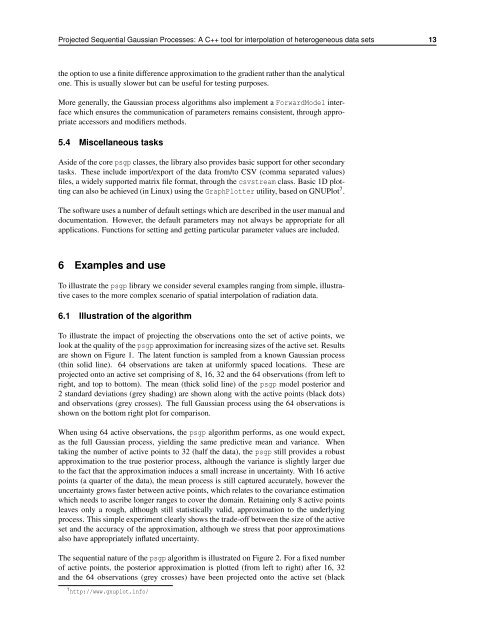Projected Sequential Gaussian Processes: A C++ tool for ... - MUCM
Projected Sequential Gaussian Processes: A C++ tool for ... - MUCM
Projected Sequential Gaussian Processes: A C++ tool for ... - MUCM
Create successful ePaper yourself
Turn your PDF publications into a flip-book with our unique Google optimized e-Paper software.
<strong>Projected</strong> <strong>Sequential</strong> <strong>Gaussian</strong> <strong>Processes</strong>: A <strong>C++</strong> <strong>tool</strong> <strong>for</strong> interpolation of heterogeneous data sets 13<br />
the option to use a finite difference approximation to the gradient rather than the analytical<br />
one. This is usually slower but can be useful <strong>for</strong> testing purposes.<br />
More generally, the <strong>Gaussian</strong> process algorithms also implement a ForwardModel interface<br />
which ensures the communication of parameters remains consistent, through appropriate<br />
accessors and modifiers methods.<br />
5.4 Miscellaneous tasks<br />
Aside of the core psgp classes, the library also provides basic support <strong>for</strong> other secondary<br />
tasks. These include import/export of the data from/to CSV (comma separated values)<br />
files, a widely supported matrix file <strong>for</strong>mat, through the csvstream class. Basic 1D plotting<br />
can also be achieved (in Linux) using the GraphPlotter utility, based on GNUPlot 7 .<br />
The software uses a number of default settings which are described in the user manual and<br />
documentation. However, the default parameters may not always be appropriate <strong>for</strong> all<br />
applications. Functions <strong>for</strong> setting and getting particular parameter values are included.<br />
6 Examples and use<br />
To illustrate the psgp library we consider several examples ranging from simple, illustrative<br />
cases to the more complex scenario of spatial interpolation of radiation data.<br />
6.1 Illustration of the algorithm<br />
To illustrate the impact of projecting the observations onto the set of active points, we<br />
look at the quality of the psgp approximation <strong>for</strong> increasing sizes of the active set. Results<br />
are shown on Figure 1. The latent function is sampled from a known <strong>Gaussian</strong> process<br />
(thin solid line). 64 observations are taken at uni<strong>for</strong>mly spaced locations. These are<br />
projected onto an active set comprising of 8, 16, 32 and the 64 observations (from left to<br />
right, and top to bottom). The mean (thick solid line) of the psgp model posterior and<br />
2 standard deviations (grey shading) are shown along with the active points (black dots)<br />
and observations (grey crosses). The full <strong>Gaussian</strong> process using the 64 observations is<br />
shown on the bottom right plot <strong>for</strong> comparison.<br />
When using 64 active observations, the psgp algorithm per<strong>for</strong>ms, as one would expect,<br />
as the full <strong>Gaussian</strong> process, yielding the same predictive mean and variance. When<br />
taking the number of active points to 32 (half the data), the psgp still provides a robust<br />
approximation to the true posterior process, although the variance is slightly larger due<br />
to the fact that the approximation induces a small increase in uncertainty. With 16 active<br />
points (a quarter of the data), the mean process is still captured accurately, however the<br />
uncertainty grows faster between active points, which relates to the covariance estimation<br />
which needs to ascribe longer ranges to cover the domain. Retaining only 8 active points<br />
leaves only a rough, although still statistically valid, approximation to the underlying<br />
process. This simple experiment clearly shows the trade-off between the size of the active<br />
set and the accuracy of the approximation, although we stress that poor approximations<br />
also have appropriately inflated uncertainty.<br />
The sequential nature of the psgp algorithm is illustrated on Figure 2. For a fixed number<br />
of active points, the posterior approximation is plotted (from left to right) after 16, 32<br />
and the 64 observations (grey crosses) have been projected onto the active set (black<br />
7 http://www.gnuplot.info/






